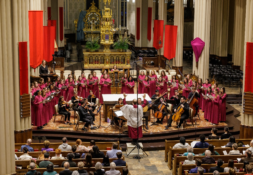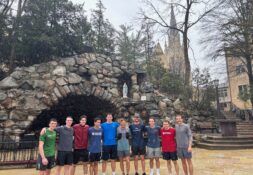A study abroad student’s report on the celebration of the saint
This year, the Republic of Ireland instituted a new public holiday to celebrate the feast of St. Brigid of Kildare. This makes St. Brigid’s Day the third Irish public holiday set on a saint’s feast day, the others being the feasts of Saints Patrick and Stephen. While this year is the first time the holiday will give the Irish public a day off work, the feast has been celebrated for centuries as both the feast of a patron saint of Ireland and in recognition of the instrumental role St. Brigid played in growing the Catholic Church in Ireland.
Because of the major cultural role St. Brigid has played in Irish history, along with the fact that the first accounts of her life were written centuries after her death, there are many theories that some of the acts and miracles associated with the saint are actually inculturated myths of Irish goddesses. When asked about this, Declan Kiberd, authority on Irish literature, emeritus professor of English, and instructor at Notre Dame’s Dublin Global Gateway, explained the historical and cultural relevance of the trend: “There has always been an attempt to tame and recruit the energy of pagan imagery [in Ireland].” Kiebert continued, “Christianity has developed the pagan imagery of Ireland.”
St. Brigid herself, Kiberd explained, could have very well been used to inculturate devotion to Irish goddesses. According to Kiberd, devotion to St. Brigid highlights the unique elements of Irish spirituality, which emphasizes “devotions to local saints and holy wells.” Irish Catholicism also emphasizes the spiritual significance of the cultural history of the nation. Kibert offered the example of Irish mythological hero, Cú Chulainn, being portrayed as a Christ-figure in art pieces as an example. St. Brigid’s treatment as a pseudo-goddess in the lore that surrounds her may have much to do with the fact that she was, indeed, a real-life Irish folk hero. Kiberd highlights this, explaining, “Brigid was a native, born and bred” in contrast to Ireland’s more internationally famous patron, St. Patrick, who was an “incomer” as a missionary bishop from modern-day Wales.
St. Brigid played an instrumental role in forming an image of Irish Catholic women. Kiberd suggests that this was a major motivating factor for the Irish government in choosing to make her feast a public holiday. He explained that women’s roles in Ireland were comparatively more pronounced than in some other parts of Christendom; St. Brigid herself is credited with founding a monastery for both men and women and co-running the community with a bishop whom she recruited to come and minister to nuns and monks alike. In fact, abbesses in that time were seen as having a jurisdiction similar to bishops, with many female authority figures from that period, St. Brigid included, seen depicted in religious art and iconography with croziers akin to that of a bishop.
However, there seems to be a shift in public focus on the figure of St. Brigid in the last few years. In an interview with the Irish Rover, Dr. Fáinche Ryan, Assistant Professor of Systematic Theology at Trinity College Dublin, explains, “The contemporary narrative emphasizes the goddess over the saint, although the saint tradition came first … [This] reflects a society that seems to be over secularized. An opportunity to do great good for women in Ireland in recalling the story of a strong leader woman is being colonized by a vision of a goddess, a fiction. Sadly many women are promoting this, too, so losing out on a wonderful opportunity.”
The doubt and confusion over St. Brigid’s historicity, paired with the mythological attribute she has inherited from absorbing a devotional mythos to pre-Christian Irish goddesses, has led to St. Brigid’s image being co-opted for a political agenda. During the 2018 abortion referendum, a dramatic and possibly intentional misreading of a story wherein the saint intercedes for a nun who has broken her vows of chastity, prevents her from conceiving a child, and allows her to reform and return to the convent, was used to push for Catholics to vote to overturn the nation’s abortion restrictions. Feminist interest group “Herstory,” uses this misrepresentation to promote St. Brigid as “our first abortionist.” Herstory also claims that a story about St. Brigid sharing her bed with a woman indicates that she was a lesbian who broke her own vows of chastity. This reading of “Cogitosus’ life of the Virgin Brigid” is problematic for an innumerable number of reasons, and it highlights the present agenda when it comes to St. Brigid’s Day, especially since Herstory identifies itself as a leading voice which advocated for the feast to become a public holiday.
Dr. Ryan, speaking about the contemporary image of St. Brigid, explained, “It reflects the very strong and popular rejection of Christianity, in particular Catholicism, and all associated with it today. An authentic recovery would be wonderful.” Ryan posited that such a recovery would lead to important questions within modern Catholicism, especially regarding “our understanding of women in leadership.” Invoking images such as that of St. Brigid working alongside her bishop to lead both male and female religious, Ryan envisions her as a “model of decisive and courageous leadership; of an equality of women and men in church life.”
The present treatment of St. Brigid highlights the importance of approaching these questions from an authentically Catholic perspective and understanding. There is, certainly, the precedent for female authority figures in the Church, but when those highlighting these women allow for such a “colonizing” degree of secularism to characterize their position, the significance of those such as St. Brigid is lost and their legacy mutilated. Such a legacy holds the potential to be transformative and grace-giving, and so it must be recovered authentically and appreciated faithfully.
William Hunter is a Junior Theology and Philosophy joint major currently studying abroad at Trinity College Dublin. When not perusing the fine selection of pubs offered in the land of saints and scholars, he can be contacted at whunter2@nd.edu
Photo Credit: Andreas F. Borchert





